Japan has a very rich avifauna to explore – there are over 720 bird species there. Whether you spot a Japanese eagle in nature or see one in a photo, its powerful hooked beaks, strong legs, and powerful talons won’t leave you indifferent!
Examples of eagles in Japan include the crested serpent-eagle, mountain hawk-eagle, greater spotted eagle, imperial eagle, golden eagle, bald eagle, white-tailed eagle, and Steller’s sea eagle.
Do some of them sound familiar? Let’s jump in and see what each of these looks and sounds like!
Table of Contents
Eagles In Japan
Crested Serpent-eagle
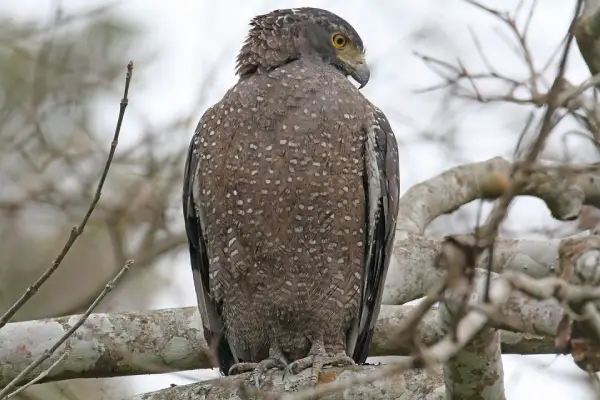
- Scientific Name: Spilornis cheela
- Length: 16.1-29.5 in
- Wingspan: 35-66.5 in
- Weight: 17-63.4 oz
These medium-sized and heavily built eagles are common in woodlands, rivers, and mangrove swamps of South and Southeast Asia.
There are 21 recognized subspecies; the one found in Japan is the Ryukyu serpent-eagle (spilornis cheela perplexus). Ryukyu serpent eagles are endemic to two islands in southern Japan, the Iriomote (formerly called Ryukyu) and Ishigaki Islands. They are year-round residents there.
Scientists can’t reach a proper conclusion about crested serpent-eagles, as some consider several of those 21 subspecies to be separate, full species.
Adult crested serpent eagles have dark brown upperparts with white spots on wings and shoulders, pale reddish-brown underparts, dark brown heads, and strongly hooked bills. As they fly over the forest canopy, they will show their rounded wings and tails with black and white bars.
Crested serpent-eagles’ most typical call consists of two or three loud and piercing notes given from January to May.
Source: Raghu.kuttan, Public domain, via Wikimedia Commons
They are monogamous birds that nest from January to April and have a clutch size of 1-2 eggs. They might occasionally lay their eggs in old nests built by other raptors.
These Japanese eagles have a diet consisting of snakes, lizards, insects, small mammals, and frogs.
Mountain Hawk-eagle
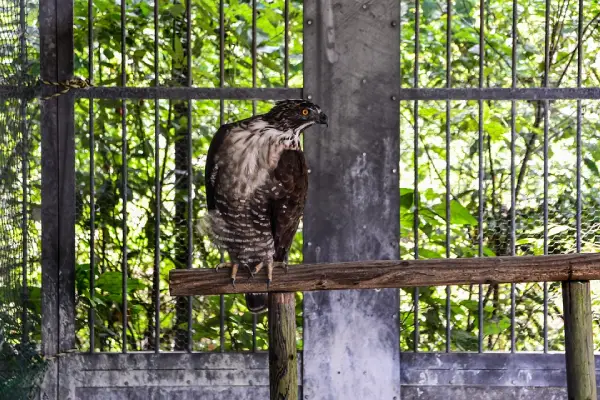
- Scientific Name: Nisaetus nipalensis
- Length: 27-33 in
- Wingspan: 52.7-68.9 in
- Weight: 5.1-6.8 lb
Mountain hawk-eagles, also known as Hodgson’s hawk-eagles, are large raptors native to Asia.
They were named after the British naturalist Brian Houghton Hodgson. Similar to other birds of prey, females are larger than males, with a size difference ranging from 3 to 20%.
There are two subspecies, the one found in Japan are Japanese mountain hawk-eagle (nisaetus nipalensis orientalis).
These eagles are year-round residents of mountainous regions from Kyushu to Hokkaido across Japan. Adults are dark brown above with rufous heads and pale, heavily streaked brown underparts. Their eyes are orange, beaks are black, and their heads have white-tipped crests.
Most noisy during their breeding season, Japanese mountain hawk-eagles will often make “pip-pee pip-pee” shrills while flying or when perched.
They are one of the most voracious raptors in the world, perching on a tree and waiting for their prey to come or jumping from one spot to another. They have a diet consisting of small and large animals (hares, martens, flying squirrels), birds, and reptiles.
They breed from April to July and lay 1-3 reddish eggs with freckles – while females incubate the eggs, males will feed them.
Japanese mountain hawk-eagles are the fourth largest eagles, after Steller’s sea eagles, white-tailed eagles, and golden eagles.
The Japanese population of mountain hawk-eagles is in decline with some estimates claiming less than 1,800 individuals in existence.
Greater Spotted Eagle

- Scientific Name: Clanga clanga
- Length: 23-29 in
- Wingspan: 61-69.7 in
- Weight: 3.3-7.2 lb
Greater spotted eagles are rare visitors to Japan but might be spotted during the non-breeding season on Kyushu Island.
These large birds of prey also known as spotted eagles have dark brown plumage, small heads, very broad wings, and short tails. Males and females look alike with females being slightly bigger.
Their scientific name comes from the Ancient Greek “clanga” which means “scream”.
Besides Japan, greater spotted eagles can be found in Europe, Africa, and other parts of Asia. During summer, they are common in forests and woodlands that have wetlands nearby to find food. When winter comes, these eagles will move to wetlands and farmlands.
Although usually silent, greater spotted eagles will make barking “kyak” calls, especially if there are other birds nearby. They will hunt in flight or wait perched in a tree before swooping down. Greater spotted eagles feed on small mammals, birds, snakes, frogs, lizards, fish, insects, and carrion – they might also steal food from other birds of prey (black kites).
Territorial and monogamous, these eagles breed from April to August. They will lay 1-3 grayish eggs with brown-gray markings that females incubate. If there are 2 eggs, the second chick will rarely survive due to siblicide.
Because of habitat loss, hunting, and hybridizing with other birds, the species is in decline and is currently listed as Vulnerable by the International Union for Conservation of Nature (IUCN).
Eastern Imperial Eagle
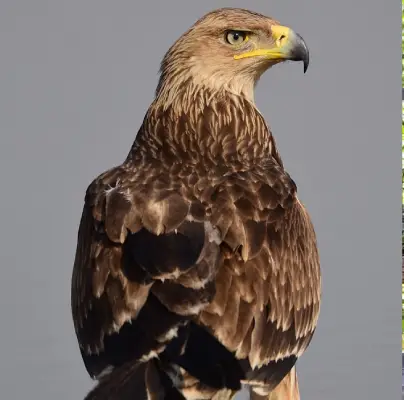
- Scientific Name: Aquila heliaca
- Length: 27-35 in
- Wingspan: 69-86.6 in
- Weight: 5.8-8.6 lb
These enormous birds of prey can be occasionally seen in southern Japan (mostly on Honshu Island).
As has been the case with previous eagles on this list, females are heavier than males, from 10 to 40%. Eastern imperial eagles can be identified by their dark brown color, whitish shoulder patches, pale heads, brown eyes, and yellow beaks.
People might confuse them for golden eagles – eastern imperial eagles have shorter tails, white shoulders, and shorter hallux claws (large rear talons they use to hunt).
They are mostly silent until their breeding season comes – in that period, they will often emit noisy barklike “rao-rao” calls.
Eastern imperial eagles live in open woodlands with thick understory where they can hunt. A couple will often hunt together, swooping down to grab their victims. Their main foods are rabbits, hares, birds, snakes, fish, insects, and lizards.
Due to habitat loss, shooting, poisoning, and nest destruction, they have been listed as Vulnerable since 1994.
Golden Eagle

- Scientific Name: Aquila chrysaetos
- Length: 26-40 in
- Wingspan: 70.8-90.1 in
- Weight: 7.9-11 lb
Golden eagles are one of the world’s largest eagle species.
One of the fastest and most agile birds of prey, they are also the most widely distributed eagle species.
Scientists recognize six subspecies of golden eagles that differ slightly in size and color – the one found in Japan is the Japanese golden eagle (Aquila chrysaetos japonica).
These eagles live in northern parts of Japan, mostly on the Hokkaido, Honshu, and Kyushu Islands. They are one of the smallest subspecies, with males weighing around 5.5 and females around 7.2 pounds.
Compared to other subspecies, these Japanese eagles have the darkest plumage contrasting with slaty-grayish black backs and crowns. Golden eagles there live in the mountains, inhabiting deciduous scrub woodlands.
Their agility and speed together with powerful feet and large, sharp talons allow golden eagles to hunt snakes, rabbits, hares, and ground squirrels. They will catch rising masses of warm air to soar in the air with very little effort and look for their next meal – when golden eagles spot their prey, they will swoop down at 200 mph.
Golden eagles are monogamous and mate for life. They are very territorial and will often attack hawks, eagles, and falcons that enter their territory.
Their numbers have been declining with around 500 Japanese golden eagles estimated to be living in the wild.
Bald Eagle

- Scientific Name: Haliaeetus leucocephalus
- Length: 28-40 in
- Wingspan: 70.8-90.5 in
- Weight: 6.6-13.9 lb
Bald eagles are the national birds of the United States.
This is why many people will be surprised to learn that these enormous raptors might occasionally visit Japan and winter there. In 2021, one bald eagle was spotted in Onne Marsh in Nemuro, Hokkaido Island. Prior to that, another was seen on Kunashiri Island in 2001.
They have brown bodies, white heads and tails, and yellow legs and beaks. Before attaining these characteristics around the age of five, bald eagles are mostly dark brown with varying amounts of white mottling.
Bald eagles are most common around coastal areas and inland areas near water.
They build one of the largest nests of any bird – the largest recorded one measured 10 feet wide and 20 feet deep. These magnificent raptors are hard to miss as they soar through the air with their 7.5-foot-wide wingspan.
Bald eagles are carnivores and opportunistic feeders that primarily consume fish they snatch from the water with their sharp talons.
Read More: What are some examples of white-headed eagles?
White-tailed Eagle
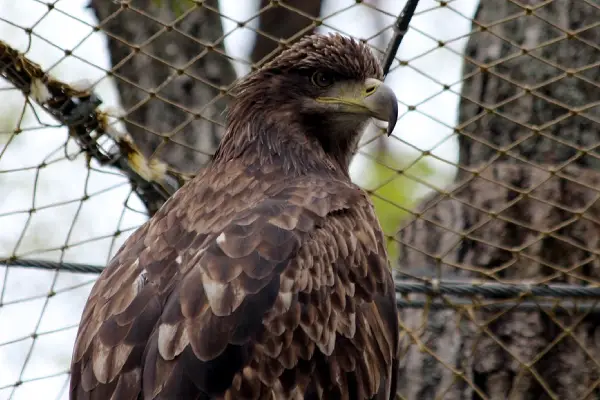
- Scientific Name: Haliaeetus albicilla
- Length: 26-37 in
- Wingspan: 70.1-96.4 in
- Weight: 6.8-15.2 lb
White-tailed eagles are massive birds found in Europe and Asia.
They are one of the largest birds of prey that measure from 26 to 37 inches long and span up to 8 feet across their wings.
Males are smaller than females – these eagles follow Bergmann’s rule stating that birds living in colder environments are larger than those found in warmer regions.
In Japan, white-tailed eagles can be seen from Hokkaido to Honshu Islands, often with their larger cousins, Steller’s sea eagles – the two will either fight in the air or on the ground over food or sit peacefully next to one another if there is no food shortage.
They are a species of sea eagles that live around aquatic habitats rich in their favorite food, fish (they also eat some birds, mammals, and carrion).
White-tailed eagles are very agile when hunting and thanks to their massive wings can be often seen soaring.
Adults are brown with white wedge-shaped tails, yellow beaks, and yellow eyes. These Japanese eagles are most vocal during the breeding season when they emit powerful calls.
Steller’s Sea Eagle
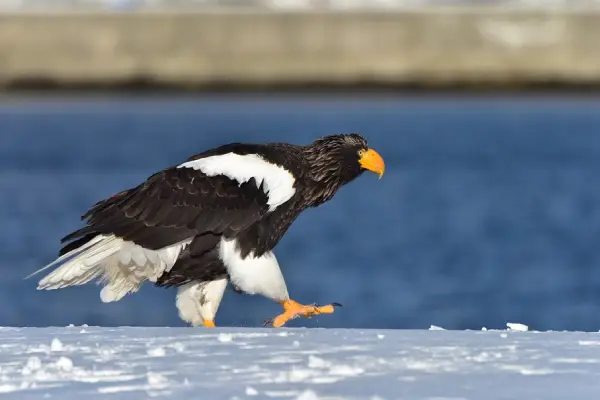
- Scientific Name: Haliaeetus pelagicus
- Length: 33.5-41.3 in
- Wingspan: 77-98.5 in
- Weight: 10.8-20.9 lb
Steller’s sea eagles are the largest eagles in Japan.
Also known as Pacific sea eagles or the white-shouldered eagles, these huge birds of prey will spend their winters primarily in northern Japan, in Hokkaido and northern Honshu Islands.
Similarly to other raptors, females are bigger than males. With a wingspan of over 8 ft, Steller’s sea eagles have one of the largest wingspans of any living eagle, and with a weight of almost 21 pounds, they are also the heaviest known eagles.
Mature adults are mostly brown-black and have large heads and massive orange-yellow beaks and talons. These birds are also easy to spot by their white foreheads, shoulders, tails, and thighs.
Steller’s sea eagles got named after the 18th-century zoologist, Georg Wilhelm Steller.
Due to their enormous sizes and attractive appearances, Steller’s sea eagles are often referred to as the world’s most magnificent birds of prey.
The IUCN listed the species as Vulnerable with some experts estimating their total population to be under 5,000 birds, with 1,700-2,300 of those wintering in Japan.
They are carnivores that mostly feed on fish, and some small mammals, ducks, gulls, and carrion.
Read More: Examples of white-chested eagles
Summary
Japan is rich in eagles. Of the 720+ bird species found there, 8 are eagles.
Hopefully, the next time you see any of these birds (from a safe distance), you will recognize them with ease!
And if you enjoyed our article, here are our other popular reads on birds: